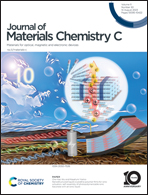Enhancing radiation-resistance of amorphous indium–zinc-oxide thin-film transistors by group IV transition element doping†
Abstract
The effect of doping with three different group IV metal cations, specifically Ti4+, Zr4+, and Hf4+, on the stability of amorphous indium–zinc-oxide (InZnO) thin-film transistors (TFTs) against 5 MeV proton irradiation was investigated. According to X-ray photoelectron spectroscopy (XPS) analysis conducted before and after proton irradiation, the higher bonding strength between oxygen ions and metal cations, which are doped in amorphous InZnO, resulted in less formation of oxygen vacancies induced by proton irradiation. Furthermore, optical absorbance spectra of oxide semiconductor films showed that doping with group IV transition elements lead to an expansion of bandgap. As with these tendencies, amorphous X-doped InZnO (X = Ti, Zr, or Hf)-based TFTs exhibited better electrical stability after proton irradiation, compared to undoped amorphous InZnO. Specifically, this study found that the order of oxygen-binding strength and bandgap widening ability of dopants directly correlated with the device stability against proton irradiation. Thus, amorphous Hf-doped InZnO-based TFT exhibited the most stable electrical performance, with an electron mobility of ∼5 cm2 V−1 s−1 and ΔVth of −0.2 V, even after exposure to 5 MeV proton irradiation.



 Please wait while we load your content...
Please wait while we load your content...